In the one-up-one-back formation, one of the players chooses to stay back (at the baseline) and his partner plays at the net (see graphic below).
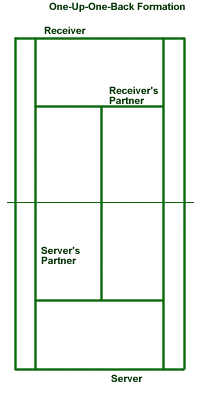
It is not recommended but in certain circumstances, it would be a smarter choice if, for example, the net skills (volleys, overheads, quick hands, etc.) are not at a sufficiently comfortable level. Obviously, the players should be encouraged to work and improve their net game since that is the easiest way to be successful in doubles.
But if you do prefer the One-Up-One-Back (OUOB) formation, here are some tips to be successful playing this way:
1. The net player should try to poach/intercept every possible shot coming from his opponents.
You might think this would be too exhausting, but think about how long a tennis point lasts… You see, you can be active during this time.
Too many times we see the net players acting as spectators watching the baseline players exchanging cross-court rallies. Instead, they should put pressure on the opposing baseline player by getting closer to the net and center in order to close the angles of the return.
If the ball passes the net player he should back up to open the court for his baseline partner to play his shot.
So the net player’s first job is to close the angles of the opposing baseline player by moving closer to the net and center; second, to poach whenever he can; and third to move back and a little to the side to open up the court for his baseline partner when this one has the ball.
As you can see, the net player should be constantly moving during the point: back and forth and side to side. It only takes a few seconds while the point lasts; no excuses… :)
2. The baseline player should cover any shot that the net player cannot intercept.
His main job is to keep the ball away from the opposing net player. If he happens to hit the ball toward the opposing net player, it is his responsibility to get to the next shot which will most likely be sent between him and his net partner or toward the net partner.
3. Covering the Lob:
First of all, every net player should try to retrieve their own lob. But if the lob is successful (clears the net player), then it will be the baseline
player’s job (if he is in position) to retrieve it.
Important:
What should the net player do if the ball goes over his head and on his side of the court?
Answer: As the baseline player is moving to return the lob, the net player should switch sides and move back joining his partner on the baseline. Why? Well, think about it… Most of the time when the baseline player returns a lob, he chooses to lob it back. And as we have seen, sometimes the return lob is a short one… that puts the opposing net player in a perfect position to “whack” the ball right at the closest opponent. That makes the net player’s moving back a perfect solution (see graphic below).
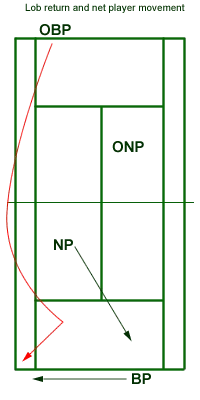
4. Serving should be done down-the-T most of the time since this puts the net player in a perfect position to poach. (see Court Coverage – doubles)
5. On the return of serve, the receiver’s partner should stay on the service line and only move up after the return has been made safely away from the opposing net player. In this way, the receiver’s partner will be in a better position just in case the server’s partner poaches (it closes the gap between him and the receiver giving him more time to react to the incoming ball).
Weaknesses of the One-Up-One-Back formation:
Since this formation is the most vulnerable one due to the big gap between players, the tactics are quite simple…
If you want to beat the OUOB formation, a good idea would be for you and your partner to charge the net. That puts two players at the net versus one player at the net.
Once both of you are up, your target is the opposing net (single) player. The single net player should not stand a chance against two aggressive volleyers.
------------------------
At the beginning level, the net players barely touch the ball – they only do it when it comes to them (when they have no choice). In these cases, the point is disputed between the two baseline players.
But let me just get straight to the point – it’s easier to win matches at the net. If you don’t feel confident playing up then practice there until you do.
If you consider the two positions: playing at the baseline (where all you can do is rally the ball cross-court and once in a while throw up a lob or surprise the opposing net player) and playing at the net (where you can put the ball away with a volley or overhead), the choice is clear – the net position is where the points are won from.
Of course, playing at the net is out of many players’ comfort zones: the balls come faster (not getting to bounce first), the reflexes/reactions must be quicker, and the action is more intense than when being at the baseline. But don’t worry about all these – with practice and a little perseverance, it will all come easily.
Here are a few tactics that you should consider when playing at the net:
1. Do not stay still.
So often we see players standing at the net and waiting for the ball to come to them. They let the rally go on between the baseline players (in the one-up-one-back formation) and they watch like spectators waiting for somebody to eventually hit the ball in their direction.
Movement is crucial at the net:
– move back a little when your baseline partner (BP) is about to hit the ball leaving room for him to create some cross-court angles if he intends to (or just to hit the ball away from the opposing net player). Also, by moving back you close the gap between you and your partner just in case the opposing net player (ONP) intercepts the ball and tries to hit between you and your partner (see graphic 1 below).
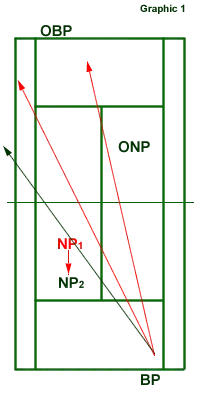
– move forward when the ball passes you and heads toward the opposing baseline player (OBP). This closes the opposing player’s angles (see graphic 2 below).
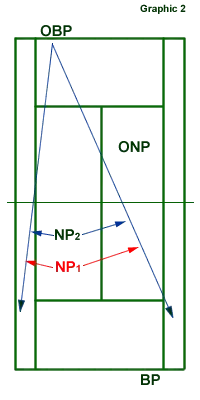
– move towards the side to where the ball is: if the ball goes wide on the other side, you move a little towards that direction (to cover the alley); if it goes towards the center, then you get ready to poach down the center (see graphic 3 below)

2. Never look back during the rally
Resist the urge to follow the ball with your eyes every time. Of course, you should look at it when it is in front of you, but if the ball just passed you (when being at the net), there is no need to look back to watch your partner (from the baseline) hitting it. After all, you cannot help him in any way if you do that.
It is very important that you keep your eyes focused on your opponents:
– Watch the opposing net player when the ball is behind you and your baseline partner is about to hit it. By doing this, you will be ready if the opposing net player intercepts/poaches the ball and hits it in your direction.
Think about what could happen if you watch your baseline partner hitting the ball and by the time you turn to see the ball going over the net, it already comes back to hit you because the opposing net player has poached. Quite uncomfortable!
So keep your eyes on the closest net player if the ball is not in your sight!
– Watch the player who has the ball, once it goes over to your opponents' territory.
Here is a drill to help you get used to keeping your eyes on your opponents during the rally:
Stand at the net, and have your partner on the baseline. On the other side, the opposing team is in a one-up-one-back formation. The two baseline players rally a ball back and forth cross-court. Your job during the rally is to shift your eyes between the opposing team’s players (don’t try to poach during this drill): when the ball is at the opposing baseline player – watch him. When the ball is at your baseline partner – watch the opposing net player, and so on.
3. Poach often
Move to intercept the ball when you are at the net even when you think you can’t reach it. Show your opponents that you are there… Make them uncomfortable by transmitting to them that you will get to their balls unless they come up with some good shots.
This tactic puts a lot of pressure on the opposing players and makes them overhit sometimes in order to pass you. That can result in a lot of unforced errors on their side.
Just imagine the following situation: if the baseline player sees that the opposing net player likes to stay still – there is no pressure to make that shot cross-court. Conversely, knowing that the net player will jump on every ball will make him think of too many alternatives to deliver the shot. That is called in tennis “paralysis by analysis” (having too many thoughts going through your mind before executing a shot) and is often the cause of errors.
Practice playing at the net until it becomes “your friend”. Only then will you be the confident doubles player that you really deserve to be.
-------------------------
Playing from the baseline in doubles is most common for beginners and some intermediate players who have not acquired a comfortable level of net play. Consistent volleys and overheads must be the norm in order to play at the net.
Coaches should not push their students to go to the net if they don’t feel prepared to do so. If players feel comfortable with their groundstrokes and find themselves making too many errors at the net, then they should stay back and play with what they have. These players should be encouraged to work and improve their net skills though since that is the easier way to dominate in the game of doubles.
If you are a player who prefers to stay back, then here are some tips to make your life easier playing doubles from the baseline:
– Position yourself on the baseline or, better yet, just inside of it. Doubles is a game of angles and therefore you should be ready to cover the low and wide shots. By staying just inside the baseline you can reach everything: drop shots, angled volleys, lobs (over your net partner’s head), etc.
– Hit the ball deep to keep the opposing team back and away from coming up to the net. Lobs and aggressive/deep groundstrokes will help you achieve just that.
– If the opposing team does prefer to attack the net then you should hit the balls shallow and low to their feet. Heavy topspin groundstrokes should help you achieve that. Avoid slicing (under-spin) groundstrokes from the baseline to defend against an attacking team. They tend to float which gives the net team time to set up for them.
– Important: Your job at the baseline is to keep the ball away from the opposing net player. Failing to do that means that you will have to cover any shot that comes from him/her.
So, if you happen to hit (or return serve) toward your net opponent it is your responsibility to retrieve the next shot – which will be most likely sent between you and your net partner or in the direction of your net partner.
-As part of playing from the baseline, your role is to direct and call the play in the sense that, from his position, you can see everything happening on the court compared to the net player who should not look back. The baseline player calls the “switch” or “stay”.
You should also alert your net partner to back off if a weak and high shot is about to be intercepted by the opposing up player.
--------------------------
As we mentioned, the role of the net player in the One-Up-One-Back strategy is crucial during the point. His actions have a major influence on the outcome of the rally. His movement affects not only the actions of the opposite team but also the opportunities created for his baseline partner.
When the baseline partner has the ball, the net player should move back, toward the service line (see graphic 1 below).

That opens up the court for his baseline partner to be creative with his shots. Not only that, by moving back he closes the gap between him and his partner making it harder for the opposing up player to hit between the two of them (in case he gets to poach). Being farther back also gives the net player more time to defend against the opposing up player’s attack.
If the ball is passing the opposing up player, the net player should move up to close the opposing back player’s angles. He should make sure that he stays behind the ball without leaving any openings for a down-the-line pass (see graphic 2 below).

On the other side, the net player should not move up when he sees the opposing up player is about to receive the ball his way.
A smart move from the net player would be to stay put (close to the service line) or move further back if the opposing up-player shows the intention of hitting an overhead (looking up and turning his body sideways).
So, it depends a great deal on how quickly the net player acts. The gap between the up and back players is exposed in accordance with their movement.
------------------------
One-Up-One-Back vs. One-Up-One-Back
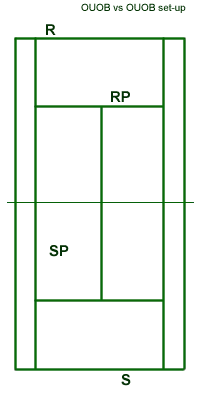
If you play in the OUOB formation against another team that prefers the same arrangement, here are some guidelines to follow:
– baseline player should try to keep the ball away from the opposing net player: sharp cross-court ground-strokes, lobs;
– the net player is the key to winning points by being very active in poaching or trying to poach anything that comes from the opposing baseline player. He should make sure to stay out of his baseline partner’s way enabling him to hit cross-court shots away from the opposing net player.
– first serves should be sent down-the-T or into-the-body as much as possible to give the net partner the opportunity to poach (see Court Coverage – doubles). The serves should be either hard-flat or hard-slice curving into the body. Those result in slow/floating returns which are ideal for put-away by the net player.
– second serves should be hit with lots of spins or toward the returner’s weak wing.
– the net player’s volleys should go frequently to either the opposing net player or in between the two players.
------------------------
One-Up-One-Back vs. Both-Up
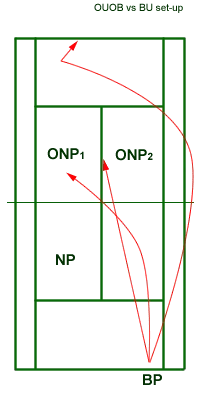
The BU team is a dangerous one. Assuming that they are good volleyers and attacking the single opposing net player, the only options to keep them out of their comfort zone would be:
– play down the middle (between the two players),
– lob them deep,
– execute low, dinky, topspin shots that land at their feet.
Make them hit up (by hitting low to their feet) or move them back (by lobbing them) then the net player should look to take advantage of the eventual defending lobs/sitters (high floating balls) from the BU (in this situation defending) team.
---------------------------
One-Up-One-Back vs. Both-Back
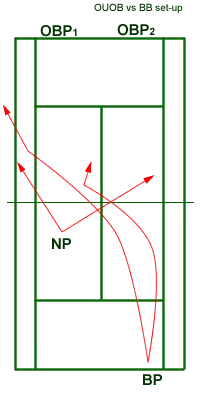
Both-Back formation is obviously used by the team that does not like to be at the net so one of the tactics would be to bring them there…
Go for drop shots, wide angle volleys from the net player, or even better… slice groundstrokes from the baseline player. Slice groundstrokes make opposing players hit the ball up, floating, at a slower pace that gives the net player plenty of time to attack and put the balls away with angled volleys.
If you manage to bring them to the net, try to keep them there longer. They will attempt to get out of that position since this is not their comfort zone.
The overhead is the stroke they hate to hit, so a good tactic would be to bring them up to the net with a drop shot and then lob them.
Since they leave an opening at the service court area, angle your groundstrokes short toward the side fence.